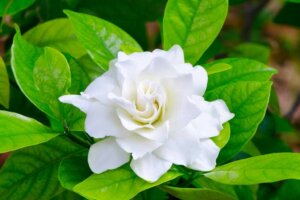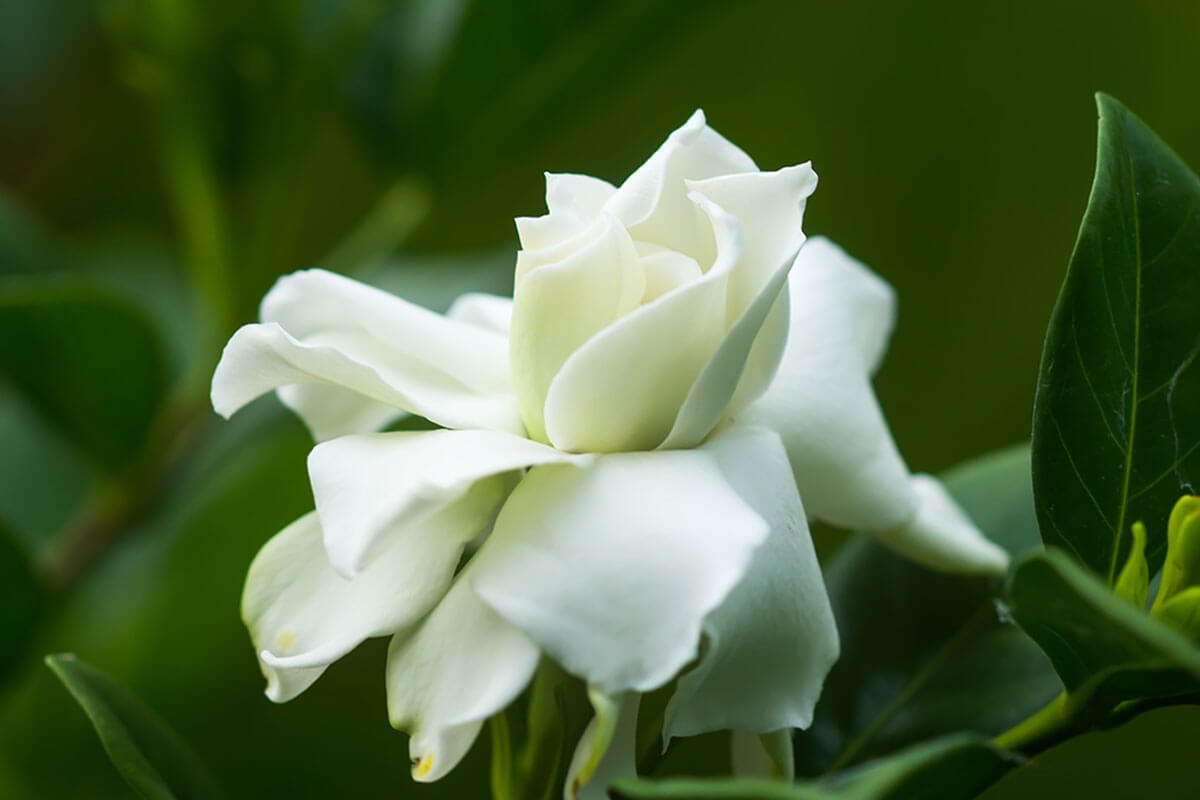Gardenias and The Scent That Makes You Fall in Love

Gardenias are shrub-like plants with green leaves and charming flowers which add to their beauty and aroma. It’s a species of flora that’s ideal for growing in open gardens or in pots. However, a higher level of growth, which exceeds 150 centimeters, only occurs when it’s sown in the ground.
In this article, we’re going to explain the most relevant details about this beautiful plant. From the outset, you should know that it requires a little more time and dedication than most other garden plants.
Gardenias: their aroma

Native to southern China, gardenias have very green, shiny lanceolate-shaped leaves. Its flowers are beautiful, similar to roses, but a little more open and less delicate. They’re usually cream-white in color and vary between five and twelve petals. However, their main attraction is the beautiful perfume they secrete that’s reminiscent of jasmine.
The scent of gardenias is so popular that it has its own song: Gardenia perfume has your mouth! It’s so penetrating that it easily permeates an entire room. Its scientific name is Gardenia Jasminiodes, which reveals where that intense aroma comes from: gardenias belong to the jasmine family.
What meaning do gardenias have?
According to the spoken tradition in some communities, gardenia flowers are related to purity, cleanliness, and spirituality. In China, they’re closely linked to femininity.
They’re also believed to help attract purifying energies and to help you stay focused during meditation. On the other hand, they’re often used to adorn marriage ceremonies as they’re said to attract love and seduction.
Gardenias and their care
Gardenias can be grown on terraces, in gardens, or indoors, as long as they have a good amount of natural light each day. This is perhaps the most important requirement regarding their care, they need sunlight to have strong leaves and flowers.
Continue reading if you want to grow gardenias at home because we’re going to tell you about the additional care they need.
They require an acidic substrate
Gardenias are acidophilic plants so they require an acidic substrate to develop better. Otherwise, they won’t absorb the nutrients they need and their leaves will turn yellow.
When you buy your gardenias, ask the expert for a growing or chestnut substrate. Keep in mind that the soil should also have good organic matter to support moisture and allow the roots to air.
Watering gardenias
Gardenias need constant watering because a completely dry substrate isn’t attractive to them. Although this doesn’t mean that you should give them excess water, as this can give way to fungi and can rot the root. It’s also very important that the water doesn’t have high levels of lime because this can change the pH of the substrate.
Fertilizer

Fertilizer keeps the substrate of your gardenias nourished, so it’s essential to apply it from time to time, especially when the plant is in a pot. You should use fertilizers for acidophilic plants that usually come in liquid form and can be mixed with irrigation water.
Gardenia pruning
The best time to do the annual or flowering pruning of gardenias is when spring begins (in cold climates) and in fall (in warm climates). Maintenance pruning, which is carried out to eliminate dry or damaged leaves should be carried out throughout the year.
Now, there’s also rejuvenation pruning and this is done when the plant is old and has already given several blooms. As its name indicates, it seeks to rejuvenate the plant. The process includes cutting many of the leaves and flowers, so this means that the plant must be well-nourished in order for it to recover.
Pests and diseases
Lastly, gardenias are susceptible to pests such as aphids, mealybugs, and spider mites. Potassium soap is very good at eliminating these types of pests. It’s also worth remembering that the deficit of light, excess or lack of watering, as well as poor care, also promotes and causes diseases in these beautiful plants.
Are you ready to grow gardenias?
As you can see, gardenias require special care, although it’s not impossible to comply with. In return, you’ll get a healthy, vibrant plant and a scent that makes you fall in love. The best thing is that you can grow it inside or outside your home. What are you waiting for? Go ahead and grow yours!
Gardenias are shrub-like plants with green leaves and charming flowers which add to their beauty and aroma. It’s a species of flora that’s ideal for growing in open gardens or in pots. However, a higher level of growth, which exceeds 150 centimeters, only occurs when it’s sown in the ground.
In this article, we’re going to explain the most relevant details about this beautiful plant. From the outset, you should know that it requires a little more time and dedication than most other garden plants.
Gardenias: their aroma

Native to southern China, gardenias have very green, shiny lanceolate-shaped leaves. Its flowers are beautiful, similar to roses, but a little more open and less delicate. They’re usually cream-white in color and vary between five and twelve petals. However, their main attraction is the beautiful perfume they secrete that’s reminiscent of jasmine.
The scent of gardenias is so popular that it has its own song: Gardenia perfume has your mouth! It’s so penetrating that it easily permeates an entire room. Its scientific name is Gardenia Jasminiodes, which reveals where that intense aroma comes from: gardenias belong to the jasmine family.
What meaning do gardenias have?
According to the spoken tradition in some communities, gardenia flowers are related to purity, cleanliness, and spirituality. In China, they’re closely linked to femininity.
They’re also believed to help attract purifying energies and to help you stay focused during meditation. On the other hand, they’re often used to adorn marriage ceremonies as they’re said to attract love and seduction.
Gardenias and their care
Gardenias can be grown on terraces, in gardens, or indoors, as long as they have a good amount of natural light each day. This is perhaps the most important requirement regarding their care, they need sunlight to have strong leaves and flowers.
Continue reading if you want to grow gardenias at home because we’re going to tell you about the additional care they need.
They require an acidic substrate
Gardenias are acidophilic plants so they require an acidic substrate to develop better. Otherwise, they won’t absorb the nutrients they need and their leaves will turn yellow.
When you buy your gardenias, ask the expert for a growing or chestnut substrate. Keep in mind that the soil should also have good organic matter to support moisture and allow the roots to air.
Watering gardenias
Gardenias need constant watering because a completely dry substrate isn’t attractive to them. Although this doesn’t mean that you should give them excess water, as this can give way to fungi and can rot the root. It’s also very important that the water doesn’t have high levels of lime because this can change the pH of the substrate.
Fertilizer

Fertilizer keeps the substrate of your gardenias nourished, so it’s essential to apply it from time to time, especially when the plant is in a pot. You should use fertilizers for acidophilic plants that usually come in liquid form and can be mixed with irrigation water.
Gardenia pruning
The best time to do the annual or flowering pruning of gardenias is when spring begins (in cold climates) and in fall (in warm climates). Maintenance pruning, which is carried out to eliminate dry or damaged leaves should be carried out throughout the year.
Now, there’s also rejuvenation pruning and this is done when the plant is old and has already given several blooms. As its name indicates, it seeks to rejuvenate the plant. The process includes cutting many of the leaves and flowers, so this means that the plant must be well-nourished in order for it to recover.
Pests and diseases
Lastly, gardenias are susceptible to pests such as aphids, mealybugs, and spider mites. Potassium soap is very good at eliminating these types of pests. It’s also worth remembering that the deficit of light, excess or lack of watering, as well as poor care, also promotes and causes diseases in these beautiful plants.
Are you ready to grow gardenias?
As you can see, gardenias require special care, although it’s not impossible to comply with. In return, you’ll get a healthy, vibrant plant and a scent that makes you fall in love. The best thing is that you can grow it inside or outside your home. What are you waiting for? Go ahead and grow yours!







